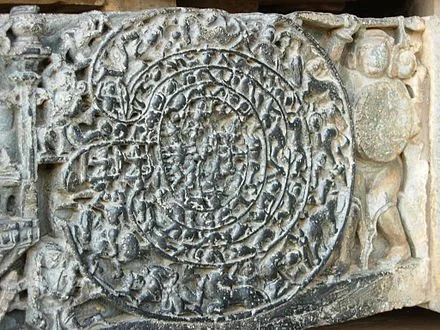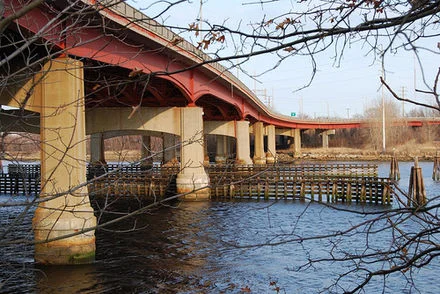
Traffic traumas
Carving showing the warrior Abhimanyu enteringa a labyrinth in the Hoysaleswara temple, Halebidu, India
Adapted from Robert Whitcomb’s “Digital Diary,’ in GoLocal24.com
On the west-bound closing on Route 195’s Washington Bridge: Once more fear and chaos triumph.
Meanwhile, I know that highway engineering can be difficult, especially in densely populated areas, but surely the Rhode Island Department of Transportation can make it easier to navigate the new rotary on the east side of the always-being-rebuilt Henderson Bridge project between Providence’s East Side and that speed-trap capital called East Providence. The current signage sends many people in circles or facing the peril of a head-on collision, especially at night and during rush hours.
Rotaries (aka “roundabouts”), by smoothing and calming traffic, can reduce accidents, and they cut pollution from the idling of gasoline-fueled vehicles and can eliminate the need for expensive traffic lights. But the signage must be very clear – especially at night.
Better study the bridge project carefully before entering it — if you can get to it through the mess/anarchy caused by the Washington Bridge’s partial closing.
And now there’s the inevitable flap over a proposed rotary in Portsmouth, R.I. Drivers, like most people, fear change.
National Register of Historic Places plaque on the first traffic circle in the United States, at the intersection of River and Pleasant streets in Yarmouth, Mass.
Meanwhile, my friend Lisette Prince, who lives in Newport, reminded me that planting ground cover instead of grass on median strips and otherwise along the roads reduces pollution caused by gasoline-powered lawn mowers, virtually eliminates erosion and can stay green without watering for much longer than grass.
Soothing Big Periwinkle ground cover
Let managers manage; watch the rowers from a fixed-up ‘Red Bridge’
The Henderson Bridge (aka “Red Bridge”) over the Seekonk River.
Adapted from Robert Whitcomb’s “Digital Diary,’’ in GoLocal24.com
Some good and bad news in Rhode Island the past few days.
Let’s start with the bad news. The well-regarded and reformist Providence schools superintendent, Christopher Maher, has decided to step down. And while he gave a frequently used explanation for exits – to spend more time with his family – another reason seems to be that he’s frustrated by the bureaucratic limits on his ability to get things done to improve the city’s schools – improvement they urgently need.
The fact is that the superintendent needs far more freedom to improve the system. World War II Adm. Chester Nimitz famously said: “When you’re in command, command,’’ but the Providence schools chief is remarkably hamstrung. As Hillary Salmons, executive director of the Providence After School Alliance, told The Providence Journal in the Feb. 27 article “Another schools chief is leaving”:
“When the City Council controls any {expenditures} over $5,000 how can anyone manage his resources? It’s going to be hard to attract leadership with a district hamstrung by these structural impediments.’’
People in authority should be given, well, authority to do what needs to be done and of course be held accountable for their decisions. I keep citing my friend Philip K. Howard’s books on red tape and bureaucratic paralysis, the latest entitled Try Common Sense. It seems very appropriate here.
There need to be changes to enable future Providence school superintendents to actually manage their department.
xxx
On a happier note is news that the nearly crumbling Henderson Bridge (aka “Red Bridge”), connecting the East Side of Providence with East Providence, will be rebuilt in a fashion to make it more of a public asset.
The new version will be narrower, with only two lanes instead of the current unnecessary four lanes (put in for a superhighway that never happened), but will include bike/pedestrian paths in both directions. Thus the bridge will offer people in our area yet another way to enjoy the views up and down the Seekonk River as it enters Narragansett Bay, and get exercise while doing it. It will be a fine place from which to watch the Brown crew and other rowers on the river,
Kudos to the Rhode Island Department of Transportation for this plan.
By the way, my favorite writer about bridges and other transportation infrastructure is Henry Petroski – e.g., see his book The Road Taken: The History and Future of America’s Infrastructure.





